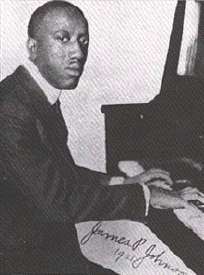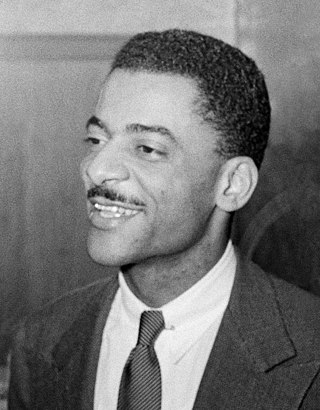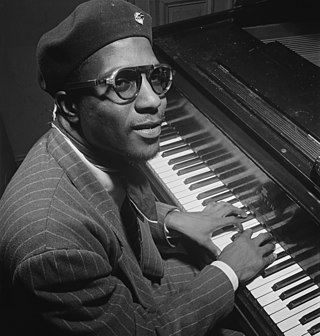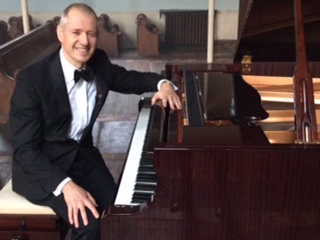
Ragtime, also spelled rag-time or rag time, is a musical style that had its peak from the 1890s to 1910s. Its cardinal trait is its syncopated or "ragged" rhythm. Ragtime was popularized during the early 20th century by composers such as Scott Joplin, James Scott and Joseph Lamb. Ragtime pieces are typically composed for and performed on piano, though the genre has been adapted for a variety of instruments and styles.

Bebop or bop is a style of jazz developed in the early to mid-1940s in the United States. The style features compositions characterized by a fast tempo, complex chord progressions with rapid chord changes and numerous changes of key, instrumental virtuosity, and improvisation based on a combination of harmonic structure, the use of scales and occasional references to the melody.

Arthur Tatum Jr. was an American jazz pianist who is widely regarded as one of the greatest ever. From early in his career, fellow musicians acclaimed Tatum's technical ability as extraordinary. Tatum also extended jazz piano's vocabulary and boundaries far beyond his initial stride influences, and established new ground through innovative use of reharmonization, voicing, and bitonality.

James Price Johnson was an American pianist and composer. A pioneer of stride piano, he was one of the most important pianists in the early era of recording, and like Jelly Roll Morton, one of the key figures in the evolution of ragtime into what was eventually called jazz. Johnson was a major influence on Count Basie, Duke Ellington, Art Tatum, Thelonious Monk, and Fats Waller, who was his student.

Charles Luckyth Roberts, better known as Luckey Roberts, was an American composer and stride pianist who worked in the jazz, ragtime, and blues styles. Roberts performed as musician, band/orchestra conductor, and dancer. He taught music and dance. He also owned a restaurant and bar in New York City and in Washington, D.C. Luckey Roberts noted compositions include "Junk Man Rag", "Moonlight Cocktail", "Pork and Beans" (1913), and "Railroad Blues".

Earl Kenneth Hines, also known as Earl "Fatha" Hines, was an American jazz pianist and bandleader. He was one of the most influential figures in the development of jazz piano and, according to one source, "one of a small number of pianists whose playing shaped the history of jazz".
Lead guitar is a musical part for a guitar in which the guitarist plays melody lines, instrumental fill passages, guitar solos, and occasionally, some riffs and chords within a song structure. The lead is the featured guitar, which usually plays single-note-based lines or double-stops. In rock, heavy metal, blues, jazz, punk, fusion, some pop, and other music styles, lead guitar lines are often supported by a second guitarist who plays rhythm guitar, which consists of accompaniment chords and riffs.

Theodore Shaw Wilson was an American jazz pianist. Described by critic Scott Yanow as "the definitive swing pianist", Wilson's piano style was gentle, elegant, and virtuosic. His style was highly influenced by Earl Hines and Art Tatum. His work was featured on the records of many of the biggest names in jazz, including Louis Armstrong, Lena Horne, Benny Goodman, Billie Holiday, and Ella Fitzgerald. With Goodman, he was one of the first black musicians to perform prominently alongside white musicians. In addition to his extensive work as a sideman, Wilson also led his own groups and recording sessions from the late 1920s to the 1980s.
In jazz, comping is the chords, rhythms, and countermelodies that keyboard players, guitar players, or drummers use to support a musician's improvised solo or melody lines. It is also the action of accompanying, and the left-hand part of a solo pianist.

A rhythm section is a group of musicians within a music ensemble or band that provides the underlying rhythm, harmony and pulse of the accompaniment, providing a rhythmic and harmonic reference and "beat" for the rest of the band. The rhythm section is often contrasted with the roles of other musicians in the band, such as the lead guitarist or lead vocals whose primary job is to carry the melody.

Fingerstyle guitar is the technique of playing the guitar or bass guitar by plucking the strings directly with the fingertips, fingernails, or picks attached to fingers, as opposed to flatpicking. The term "fingerstyle" is something of a misnomer, since it is present in several different genres and styles of music—but mostly, because it involves a completely different technique, not just a "style" of playing, especially for the guitarist's picking/plucking hand. The term is often used synonymously with fingerpicking except in classical guitar circles, although fingerpicking can also refer to a specific tradition of folk, blues and country guitar playing in the US. The terms "fingerstyle" and "fingerpicking" are also applied to similar string instruments such as the banjo.

Jazz piano is a collective term for the techniques pianists use when playing jazz. The piano has been an integral part of the jazz idiom since its inception, in both solo and ensemble settings. Its role is multifaceted due largely to the instrument's combined melodic and harmonic capabilities. For this reason it is an important tool of jazz musicians and composers for teaching and learning jazz theory and set arrangement, regardless of their main instrument. By extension the phrase 'jazz piano' can refer to similar techniques on any keyboard instrument.

Novelty piano is a genre of piano and novelty music that was popular during the 1920s. A successor to ragtime and an outgrowth of the piano roll music of the 1910s, it can be considered a pianistic cousin of jazz, which appeared around the same time. "Nola," a 1915 composition by New York pianist Felix Arndt, is generally considered the first novelty piano hit. Many early novelty composers were piano roll artists from the Chicago area, where two of the largest piano roll companies, QRS and Imperial, were based. While often only lightly syncopated or lacking syncopation entirely, novelty piano influenced the evolution of jazz. It is distinct from stride piano, which was developed in New York at about the same time.

Dave McKenna was an American jazz pianist known primarily as a solo pianist and for his "three-handed" swing style. He was a significant figure in the evolution of jazz piano.
A cutting contest is a type of musical battle that was traditionally held between various stride piano players from the 1920s to the 1940s, and to a lesser extent in improvisation contests on other jazz instruments during the swing era.

Martin Litton is a British jazz pianist born in Grays, Essex, UK, noteworthy for his early work with Kenny Ball from 1983 to 1984 on his tour of the Middle East and tour of Russia and for a recording session with Humphrey Lyttelton. Litton's fluency of style(s) and the historical context he brings to his jazz piano has taken him around the world, playing with and respected by many of the great names in jazz, past and present. His keyboard skills have been honed by his attention to detail and personal discipline both in terms of musicianship as well as knowledge of the development of jazz piano.
In music, the term swing has two main uses. Colloquially, it is used to describe the propulsive quality or "feel" of a rhythm, especially when the music prompts a visceral response such as foot-tapping or head-nodding. This sense can also be called "groove".
Blues, Rags and Stomps, Op. 1, was composed by Robert Boury between 1970-1973. It consists two books, three movements each. Boury composed mostly during his graduate study at the University of Michigan in Ann Arbor. The first set was nicknamed “Varsity Rags”, which Eubie Blake admired and told the audience, “Now that’s ragtime”, after he heard Boury’s performance at the 1971 Toronto ragtime Festival. Book I and II consist of three movements each: I. A Tristan Two-Step, II. Alice Walking, and III. The Rocket’s Red Glare. Book II: I. Eubie’s Blues, II. Stroller in Air, III. I Left My Heart. Boury comments that “A Tristan Two-step” represents his breakaway from modern music and was a way to be accepted as a tonal composer.
Judy Carmichael is a Grammy-nominated jazz pianist and vocalist who specializes in a form of early jazz called "Stride Piano". She has been honored as a Steinway Artist. Carmichael is also the first jazz musician sponsored by the United States Government to tour China.
St. Nick's Jazz Pub located at 773 St. Nicholas Avenue, in New York City, in the area of Harlem known as Sugar Hill, Manhattan. It was one of the oldest continuous operating jazz club in Harlem specializing in jazz and blues. In the 1930s, it was known as Poosepahtuck. In the 1940s, it was known as Lucky's Rendezvous and owned by Luckey Roberts. Roberts was Duke Ellington's and George Gershwin's teacher and mentor. Artists such as Art Tatum, Donald Lambert, Marlowe Morris, Duke Ellington, and Clifton Webb performed at the Rendezvous.













